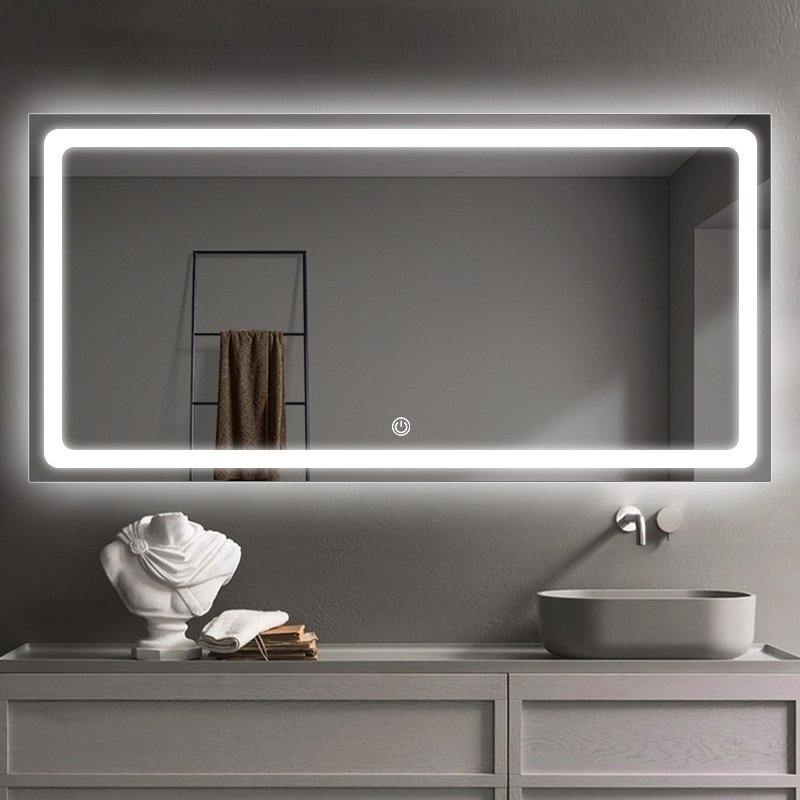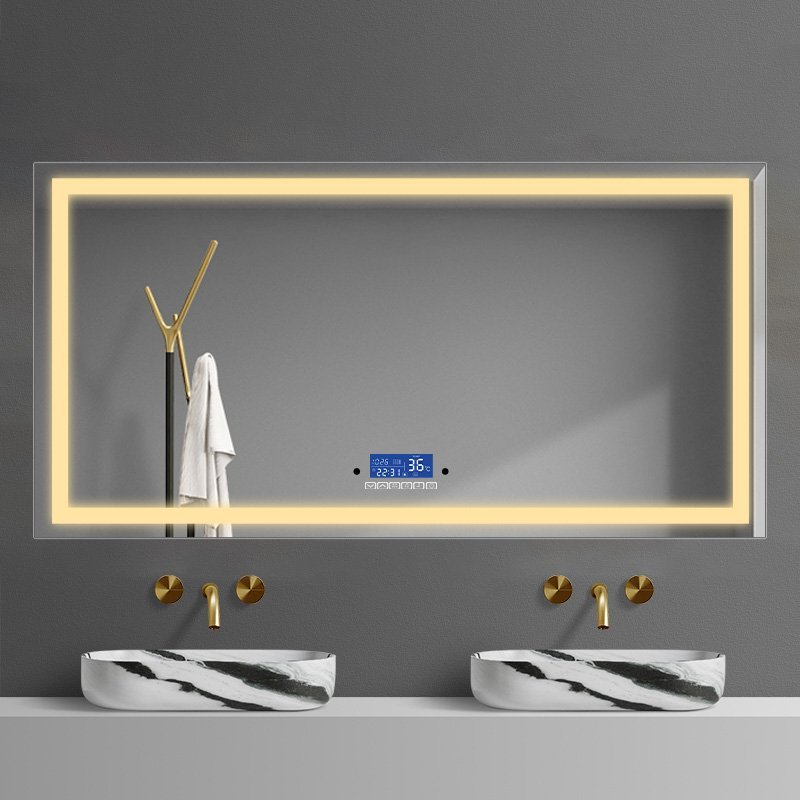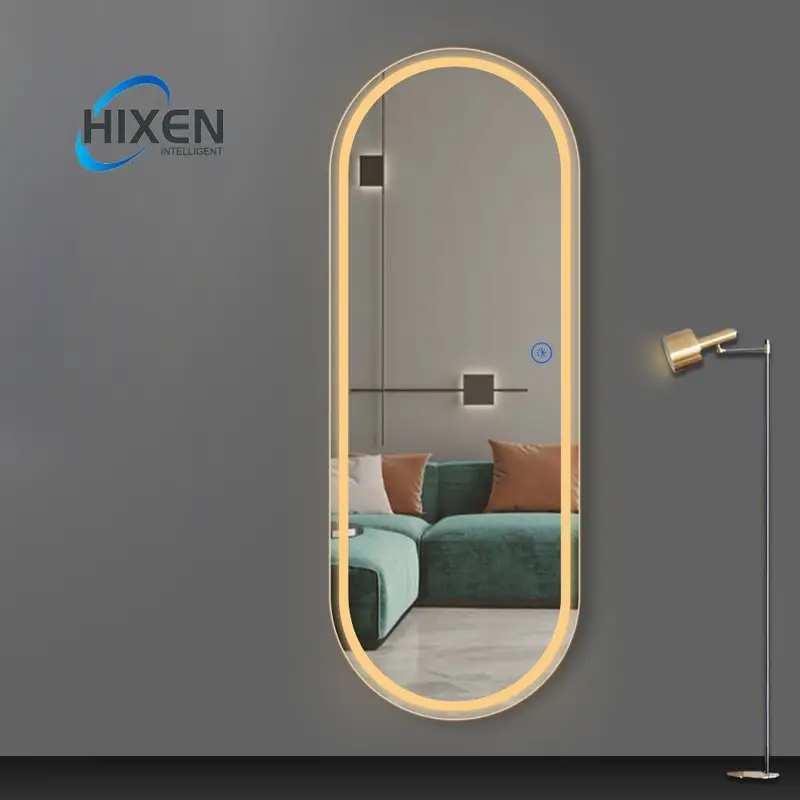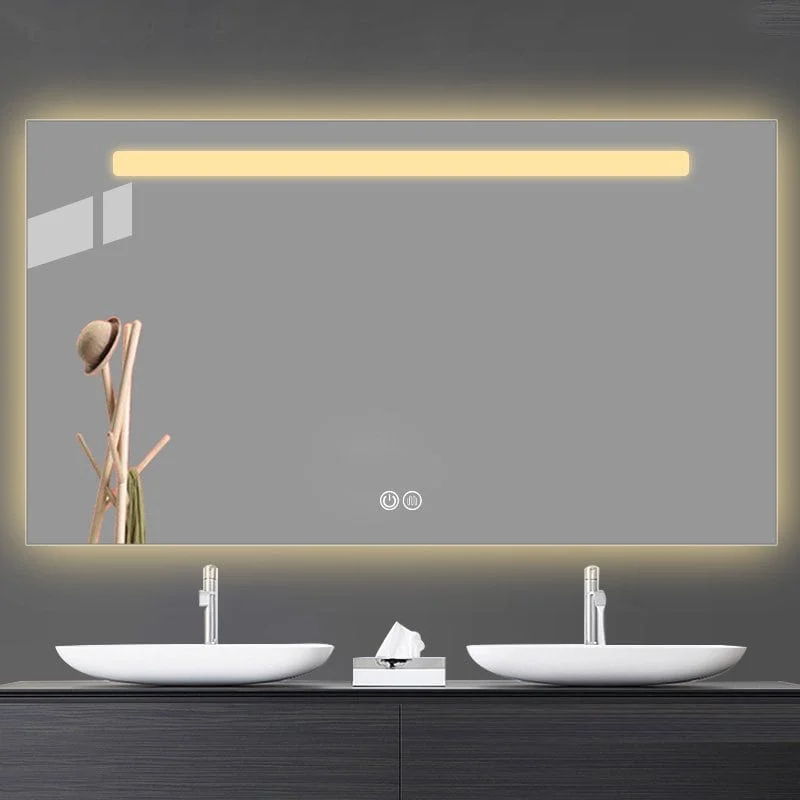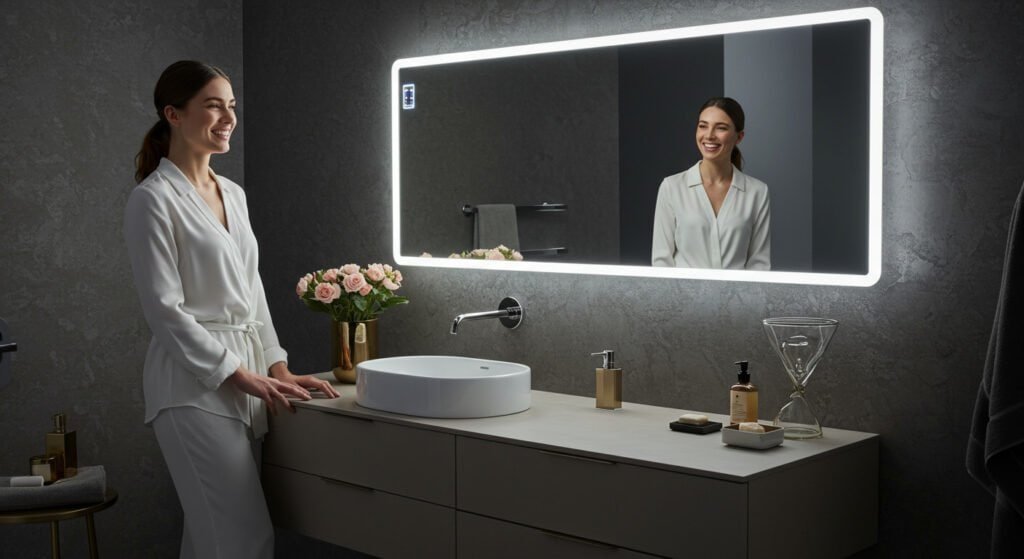|
Obtenir votre Trinity Audio joueur prêt ...
|
Les miroirs LED en valent-ils la peine? De nombreux propriétaires font face à l'incertitude lors du choix entre les miroirs traditionnels de salle de bain et les alternatives LED modernes, s'inquiéter souvent des coûts initiaux plus élevés. Cette décision devient plus pressante lorsque le mauvais éclairage affecte les routines quotidiennes comme l'application de maquillage ou le rasage.
Les miroirs LED valent absolument l'investissement pour la plupart des propriétaires. Ils offrent une efficacité énergétique supérieure, durée de vie prolongée de 50,000+ heures, Options d'éclairage personnalisables, et des fonctionnalités intelligentes intégrées qui améliorent les fonctionnalités quotidiennes tout en offrant des économies de coûts à long terme grâce à une consommation d'électricité réduite.
Explorons l'analyse complète pour vous aider à déterminer si les miroirs LED s'alignent avec vos besoins et budget spécifiques.
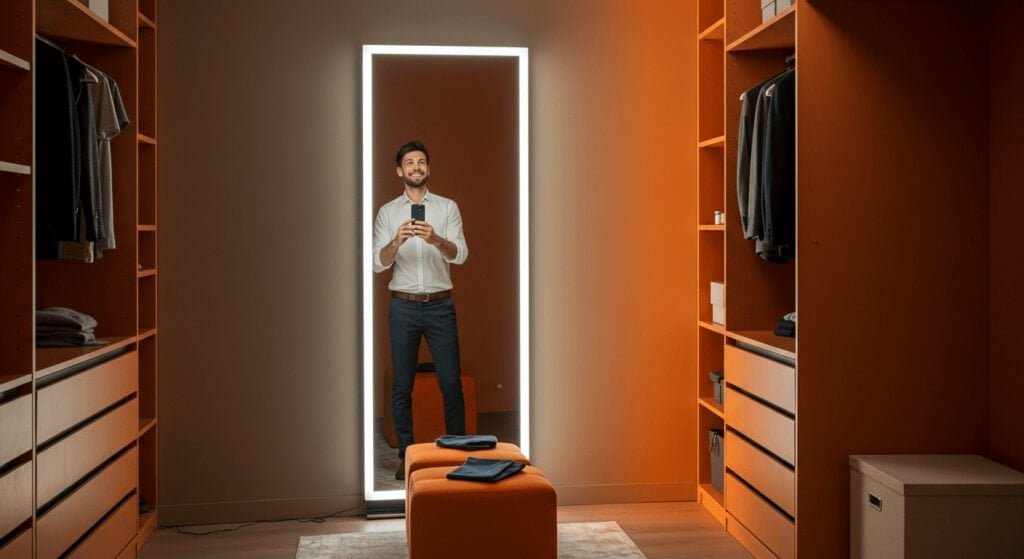
Quels sont les avantages fondamentaux des miroirs LED?
Les miroirs LED représentent une progression importante dans la technologie d'éclairage des toilettes et de la vanité, combiner la fonctionnalité des miroirs traditionnels avec les systèmes d'éclairage modernes.
Le Meilleurs miroirs de salle de bain LED Fournir une efficacité énergétique exceptionnelle, consommer 80% Moins d'électricité que l'éclairage à incandescence traditionnel tout en offrant un contrôle de luminosité supérieur. La technologie LED offre une température de couleur réglable allant de 3000K chauds à 6000k frais, Permettre aux utilisateurs de personnaliser l'éclairage pour différentes activités.
Moderne Miroirs LED pour la vanité Les applications intègrent plusieurs fonctionnalités avancées, y compris les éléments de chauffage anti-buts, capteurs tactiles pour opération mains libres, Connectivité Bluetooth pour le streaming de musique, et les affichages numériques montrant le temps et la température. Le miroir rétroéclairé Le design crée un éclairage ambiant qui élimine les ombres dures, offrant même un éclairage sur toute la surface de réflexion.
De qualité professionnelle miroir LED Les unités comprennent souvent les zones de grossissement, Les rendre idéaux pour des tâches de toilettage détaillées. Ces miroirs comportent généralement des capacités de commutation d'éclairage en trois couleurs, Permettre à la transition transparente entre différents modes d'éclairage pour correspondre à divers moments de la journée ou des activités spécifiques.
Les miroirs de salle de bain éclairés en valent-ils la peine?
Les environnements de salle de bain présentent des défis uniques qui font miroir de salle de bain éclairé Solutions Investissements particulièrement précieux pour les propriétaires à la recherche de fonctionnalités améliorées.
Miroir léger de la salle de bain Les installations fournissent un éclairage cohérent quelles que soient les conditions d'éclairage aérien, Éliminer les ombres qui interfèrent avec les activités de toilettage. Le système d'éclairage intégré s'avère particulièrement bénéfique lors des routines tôt le matin ou le soir lorsque la lumière naturelle est insuffisante.
L'environnement de salle de bain riche en humidité fait miroirs de vanité éclairée essentiel pour maintenir une visibilité claire. Qualité miroir de salle de bain conduit Les unités incorporent Technologie anti-Fog qui empêche l'accumulation de condensation, Assurer une utilisation ininterrompue immédiatement après les douches chaudes. Miroirs éclairés modernes pour salles de bains Caractéristiques IP44 ou les cotes de résistance à l'eau supérieures, garantir une opération sûre dans des conditions humides.
Le miroirs de vanité de salle de bain Avec un éclairage intégré, éliminez le besoin d'installation de lumières de vanité séparées, Réduire la complexité électrique et créer des lignes esthétiques plus propres. Miroirs de vanité éclairée pour salle de bain Les applications incluent généralement des capacités de gradin, Permettre aux utilisateurs d'ajuster les niveaux de luminosité en fonction des conditions ambiantes et des préférences personnelles, les rendre supérieurs à la traditionnelle miroir de salle de bain options.
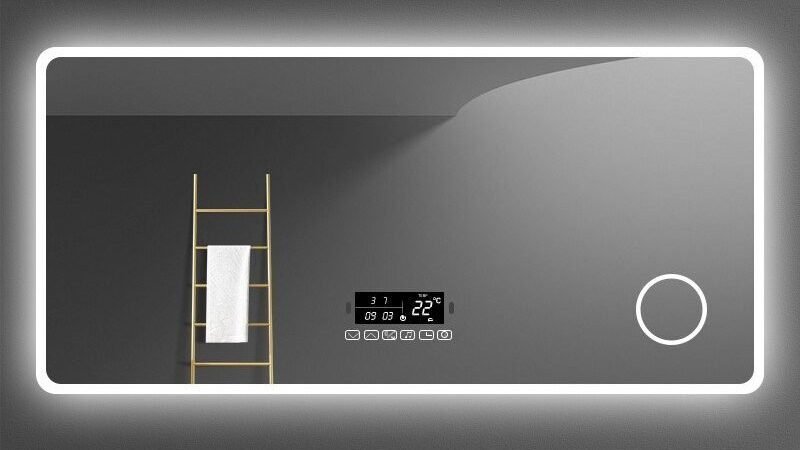
Quels sont les avantages et les inconvénients des miroirs éclairés?
Comprendre le Pour les avantages et les inconvénients des miroirs éclairés permet aux propriétaires de prendre des décisions équilibrées en fonction de leurs exigences et circonstances spécifiques.
Miroir de maquillage éclairé La technologie offre des avantages importants, y compris l'efficacité énergétique, températures d'éclairage personnalisables, durée de vie prolongée, et fonctionnalités intelligentes intégrées, tandis que les inconvénients potentiels incluent des coûts initiaux et une complexité d'installation plus élevés par rapport aux miroirs traditionnels.
| Avantages | Désavantage |
|---|---|
| Efficacité énergétique (80% Moins de consommation) | Coût d'investissement initial plus élevé |
| Longue durée de vie (50,000+ heures) | Complexité d'installation potentielle |
| Température de couleur personnalisable | Options de réparation limitées |
| Fonctionnalité anti-Fog | Dépendance à l'alimentation électrique |
| Intégration des fonctionnalités intelligentes | Problèmes d'uniformité légère possibles |
| Illumination sans ombre | Limitations de style par rapport aux cadres traditionnels |
Miroir de vanité avec des lumières LED Les installations offrent des performances cohérentes avec des exigences de maintenance minimales. Le Vanité miroir lumineuse LED La configuration élimine le besoin de luminaires d'éclairage séparés, Créer une esthétique rationalisée pendant que Réduire les coûts d'installation électrique globaux. Cependant, Miroir de vanité allumé Les unités nécessitent un examen attentif des exigences électriques et peuvent nécessiter une installation professionnelle pour les configurations câblées. Miroir mural avec des lumières Les conceptions offrent des solutions d'économie d'espace mais peuvent limiter la flexibilité dans le positionnement du miroir par rapport aux miroirs montés traditionnels.
Combien de temps durent les miroirs LED?
La longévité du miroir LED représente un facteur crucial pour déterminer la valeur d'investissement globale et la satisfaction à long terme avec les installations miroir éclairées.
Les miroirs LED de qualité durent généralement entre 50,000 à 100,000 heures de fonctionnement, équivalent à 25-50 années d'utilisation des ménages normaux, surpassant considérablement les systèmes d'éclairage à incandescence traditionnels qui nécessitent des remplacements fréquents.
La durée de vie prolongée de miroirs avec cadre noir et les systèmes LED intégrés découlent de la nature à l'état solide de la technologie LED, ce qui génère moins de chaleur et éprouve une dégradation minimale au fil du temps. Miroirs de salle de bain rectangulaire Avec l'intégration LED, maintenez une sortie lumineuse cohérente tout au long de leur vie opérationnelle, avec la plupart des unités de qualité qui retiennent 90% de luminosité d'origine après 25,000 heures.
Le idées de miroir de chambre L'incorporation de la technologie LED bénéficie de cette longévité, Les rendre particulièrement adaptés aux zones à usage élevé. Petit miroir de salle de bain Les installations avec un éclairage LED fournissent des décennies de service fiable, Éliminer les inconvénients et le coût de l'entretien fréquent. Miroir de salle de bain moderne Designs Tendre l'effet avancé Technologie des puces LED qui garantit la cohérence des couleurs et la stabilité de la luminosité tout au long du cycle de vie du produit, En leur faisant des investissements supérieurs à long terme par rapport aux solutions d'éclairage traditionnelles.
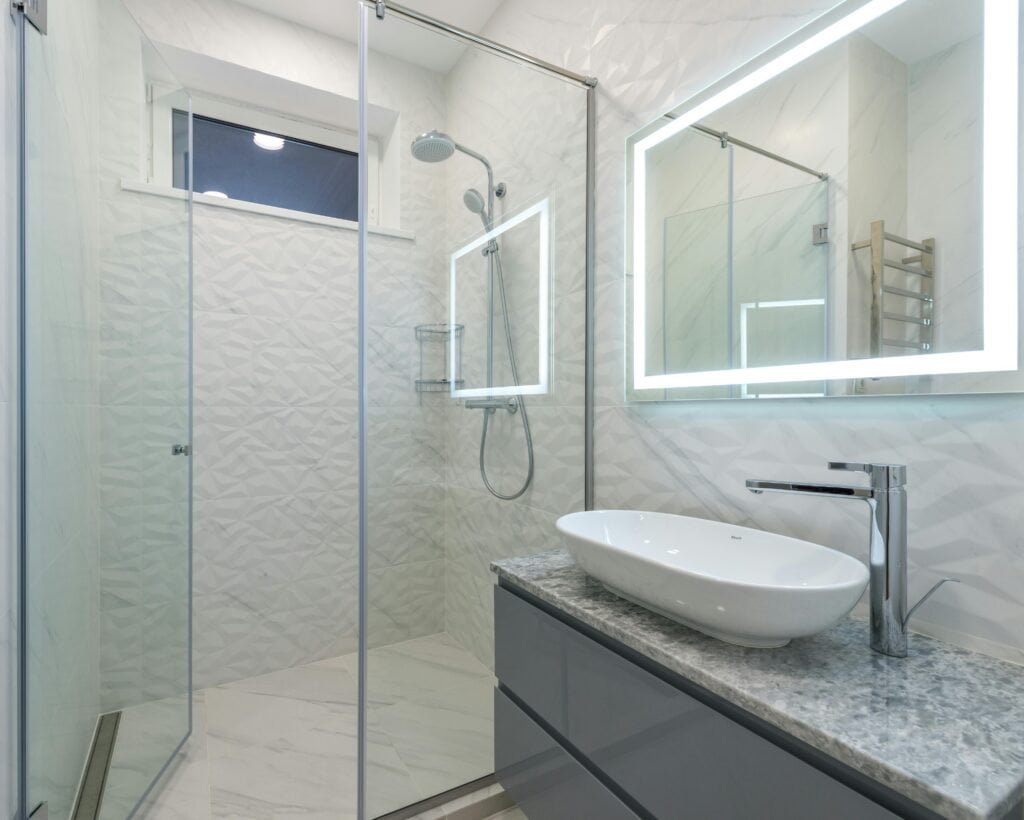
Quels sont les inconvénients des miroirs LED?
Tandis que les miroirs LED offrent de nombreux avantages, Comprendre leurs limites aide à définir des attentes réalistes et à informer les décisions d'achat.
Les inconvénients du miroir LED comprennent des coûts d'achat initiaux plus élevés, complexité d'installation potentielle, Réparation limitée, dépendance électrique, et les variations de rendu des couleurs possibles par rapport aux conditions d'éclairage naturel.
La principale préoccupation avec miroir rétroéclairé Les installations impliquent l'investissement initial, qui varie généralement de deux à cinq fois plus élevées que traditionnelles miroir en verre alternatives. Miroir de vanité éclairée Les unités nécessitent des connexions électriques, limiter la flexibilité du placement et potentiellement nécessitant une installation professionnelle pour les configurations câblées.
La nature intégrée des composants LED signifie que les défaillances de lumière individuelles peuvent nécessiter un remplacement unitaire complet plutôt que de simples changements de bulbe. Certains utilisateurs signalent que miroir de salle de bain éclairé Les unités peuvent produire de légers sons de bourdonnement, en particulier dans les modèles compatibles avec le gradateur.
Le rendu des couleurs peut varier entre différents miroir LED fabricants, avec des unités de qualité inférieure produisant potentiellement des tons légers durs ou peu flatteurs. En plus, le design élégant de la plupart Vanity Lights Les miroirs intégrés peuvent ne pas compléter l'esthétique de salle de bain traditionnelle ou vintage, limiter la flexibilité de conception par rapport aux combinaisons de miroir et d'éclairage séparées.
Avez-vous besoin d'un électricien pour l'installation du miroir LED?
Les exigences d'installation varient considérablement en fonction du type de miroir LED, configuration électrique, et les codes du bâtiment locaux, affectant les coûts globaux du projet et la complexité.
Le plus de plug-in miroir de vanité conduit Les unités permettent une installation de bricolage, Bien que câblé Vanité de salle de bain lumières L'intégration nécessite généralement des services d'électricien agréés pour garantir la conformité et la protection de la garantie en matière de sécurité.
Simple miroir LED Des modèles avec des connexions de bouchons standard peuvent être installés par les propriétaires avec des compétences de bricolage de base, nécessitant uniquement un montage sécurisé et un accès aux prises électriques. Cependant, Installations câblées impliquant Vanity Lights Intégration Demande de travail électrique professionnel pour répondre aux codes du bâtiment locaux et aux normes de sécurité. La complexité d'installation augmente lors de l'intégration des fonctionnalités intelligentes, gradateur, ou des éléments de chauffage anti-Fog qui nécessitent des circuits électriques dédiés.
De nombreux fabricants spécifient les exigences d'installation professionnelles pour maintenir la couverture de la garantie, en particulier pour la prime miroir rétroéclairé unités avec une fonctionnalité avancée. Les électriciens agréés garantissent une protection GFCI appropriée, Sélection appropriée de la jauge en fil, et conformité aux exigences de sécurité électrique des salles de bain, faire de l'installation professionnelle un investissement valable pour permanent miroir de vanité éclairée installations.
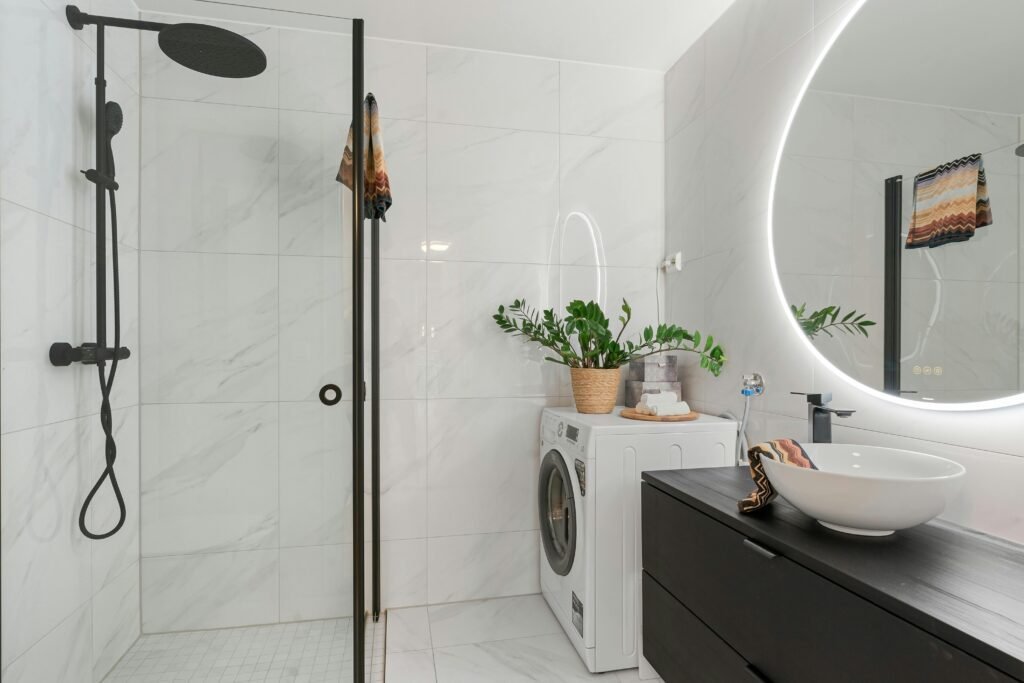
Les miroirs LED brûlent-ils?
Comprendre les modes de défaillance LED aide les utilisateurs à définir les attentes appropriées et à planifier des exigences de maintenance à long terme.
Les miroirs LED ne sont pas “griller” comme les ampoules traditionnelles mais progressivement diminué avec le temps, maintenir généralement 70% luminosité après 50,000 heures, la défaillance complète étant rare et généralement liée à l'électronique du conducteur plutôt qu'aux puces LED.
| Composant | Durée de vie typique | Mode de défaillance | Options de remplacement |
|---|---|---|---|
| Puces LED | 50,000-100,000 heures | Gradation graduelle | Généralement pas remplaçable |
| Moteur électrique | 30,000-50,000 heures | Échec complet | Parfois remplaçable |
| Commandes tactiles | 100,000+ activations | Échec du bouton | Rarement remplaçable |
| Chauffage anti-buas | 40,000+ heures | Échec de l'élément chauffant | Généralement pas remplaçable |
La nature à l'état solide de la technologie LED signifie que les LED individuelles échouent rarement catastrophiquement. Plutôt, miroir LED Les unités éprouvent une réduction progressive de sortie de lumière sur de nombreuses années de fonctionnement. Lorsque les échecs se produisent, Ils impliquent généralement le pilote d'alimentation ou l'électronique de contrôle plutôt que les éléments LED eux-mêmes. Conception de fabricants de qualité miroir rétroéclairé systèmes avec des tableaux LED redondants, S'assurer que les échecs LED uniques n'ont pas un impact significatif sur l'éclairage global. Le plus premium miroir de vanité éclairée Les installations incluent la couverture de garantie pour les défaillances des composants électroniques, Offrir une protection contre les échecs prématurés pendant la durée de vie opérationnelle attendue.
Les gens aiment-ils les miroirs LED?
La satisfaction des consommateurs et l'acceptation du marché fournissent des informations précieuses sur les performances du miroir LED et l'expérience utilisateur à travers différentes données démographiques et applications.
Les études de marché indiquent 85% Taux de satisfaction client avec les achats de miroir LED, avec les utilisateurs appréciant particulièrement l'efficacité énergétique, qualité d'éclairage, et fonctionnalités intelligentes intégrées, bien que certains expriment des préoccupations concernant les coûts initiaux et la complexité d'installation.
Les avis sur les clients mettent systématiquement à souligner la commodité de miroir de maquillage éclairé fonctionnalité, Surtout pour les tâches de toilettage de précision et l'application de maquillage. Les utilisateurs signalent une amélioration significative de la qualité de l'éclairage des salles de bain, avec beaucoup notant que Miroir de vanité allumé Les installations ont éliminé les problèmes d'observation précédents. La capacité anti-Fog reçoit des éloges particuliers des clients qui avaient auparavant des difficultés avec la condensation miroir après l'utilisation de la douche.
Cependant, Certains utilisateurs expriment les périodes de réglage initiales aux températures de couleur LED, en particulier ceux qui passent d'un éclairage à incandescence chaude. Les concepteurs professionnels recommandent de plus en plus des installations de miroir LED pour les rénovations de salle de bain modernes, citant à la fois des avantages fonctionnels et un attrait esthétique. L'adoption croissante du marché, avec des ventes de miroir LED augmentant 40% annuellement, reflète une forte acceptation et satisfaction des consommateurs à l'égard de la technologie.
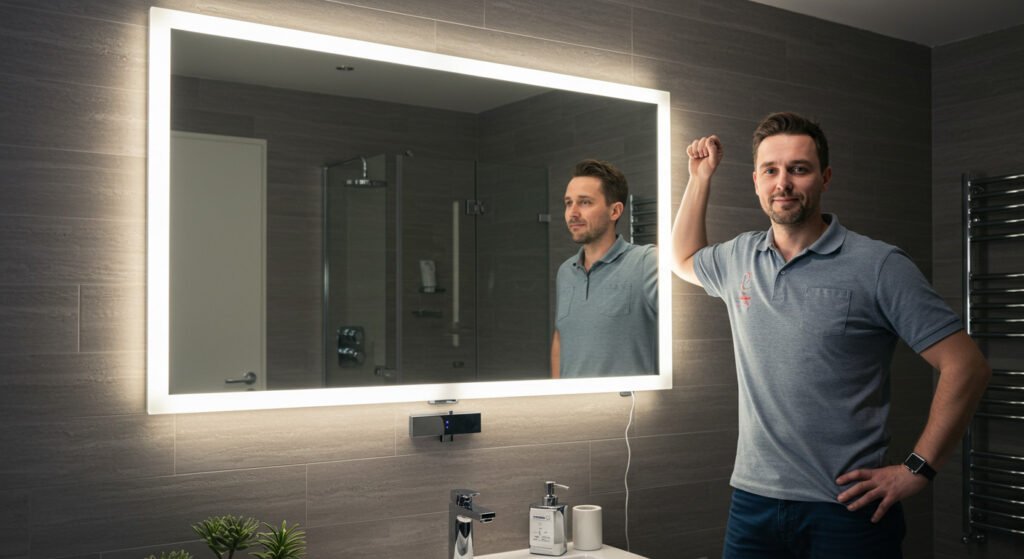
Devez-vous brancher les miroirs LED?
Les options d'alimentation pour les miroirs LED varient considérablement, affectant la flexibilité de l'installation, esthétique, et commodité à long terme pour différentes configurations de salle de bain.
Les miroirs LED offrent à la fois des options d'alimentation rechargeables et câblées, avec des modèles de plug-in offrant une flexibilité d'installation tandis que les versions câblées créent une esthétique plus propre et une intégration permanente avec les systèmes électriques de salle de bain.
Plug-in miroir de vanité conduit Les modèles se connectent aux prises électriques standard, Les rendre idéaux pour les propriétés ou les situations de location où une installation permanente n'est pas souhaitée. Ces unités incluent généralement des systèmes de gestion des cordons pour minimiser l'impact visuel tout en maintenant la flexibilité de l'installation. Câblé Vanité de salle de bain lumières L'intégration élimine les cordons visibles et fournit une intégration transparente avec les systèmes électriques de salle de bain, Créer des lignes esthétiques plus propres.
Certains premium miroir LED Les modèles offrent des options de double puissance, Autoriser l'utilisation initiale du plug-in avec une conversion ultérieure en installation câblée. Des options alimentées par batterie existent pour des applications spécialisées, Bien que ceux-ci offrent généralement des fonctionnalités limitées et nécessitent une charge régulière. Le choix d'alimentation a un impact significatif sur les coûts d'installation, Avec des versions de plug-in nécessitant une configuration minimale tandis que les installations câblées nécessitent un travail électrique professionnel et une installation de circuit potentiellement nouvelle.
Que rechercher lors de l'achat d'un miroir LED?
La sélection du miroir LED approprié nécessite une évaluation minutieuse de plusieurs spécifications techniques, caractéristiques fonctionnelles, et des indicateurs de qualité pour assurer une satisfaction à long terme.
Les critères de sélection des clés comprennent la cote IP pour la résistance à l'humidité, Température de couleur réglable (3000K-6000K), capacité de gradation, Fonctionnalité anti-Fog, couverture de garantie, et proportions de taille appropriées pour l'espace d'installation.
Les considérations de taille devraient tenir compte de la largeur de la vanité, avec optimal miroirs de salle de bain rectangulaire Mesure généralement 70-80% de largeur de vanité pour les proportions équilibrées. La mesure de la production légère dans les lumens assure un éclairage adéquat, avec la plupart des applications de salle de bain nécessitant 1000-1500 lumens pour une fonctionnalité optimale. La flexibilité de la température de couleur permet la personnalisation pour différentes activités, avec des températures chaudes (3000K) Idéal pour la relaxation et les températures fraîches (5000K-6000K) Mieux pour les tâches de précision.
Les éléments de chauffage anti-Fog s'avèrent essentiels dans les environnements à haute humidité, Empêcher l'accumulation de condensation qui altère la fonctionnalité miroir. Fonctionnalités intelligentes telles que les commandes tactiles, Connectivité Bluetooth, et les écrans numériques ajoutent la commodité mais augmentent la complexité et les points de défaillance potentiels. Les indicateurs de qualité comprennent les garanties de fabricant réputées, Certifications de sécurité appropriées, et des matériaux de construction robustes qui assurent la durabilité à long terme dans les environnements de salle de bain.
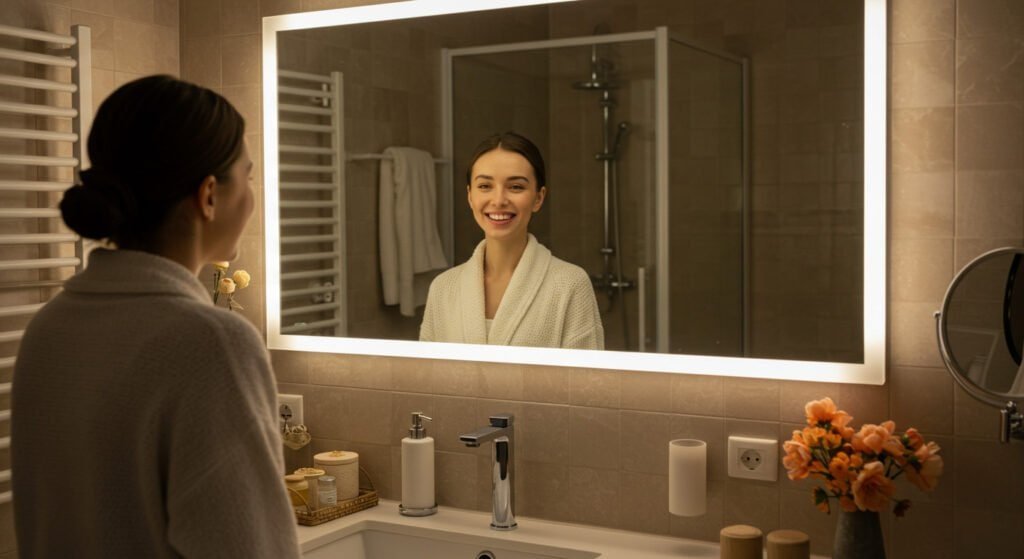
Analyse du retour des investissements Mirror LED
Les considérations financières s'étendent au-delà du prix d'achat initial pour inclure les coûts d'exploitation à long terme, Économies d'énergie, et la fréquence de remplacement par rapport aux solutions d'éclairage traditionnelles.
Les miroirs LED réalisent généralement des périodes de récupération de 3-5 années grâce à des économies d'énergie et à une réduction des coûts d'entretien, tout en offrant une fonctionnalité améliorée et potentiellement augmenter la valeur des propriétés grâce à des mises à niveau modernes de salle de bain.
L'analyse de la consommation d'énergie révèle des économies à long terme significatives, avec des miroirs LED consommant environ 20-30 watts par rapport à 100-150 watts pour l'éclairage de vanité à incandescence équivalent. Les économies de coûts d'électricité annuelles vont de $30-80 en fonction des tarifs des services publics locaux et des modèles d'utilisation. La réduction des coûts d'entretien élimine les remplacements fréquents de bulbe, Économiser à la fois les coûts des matériaux et le temps de travail sur la durée de vie opérationnelle du miroir.
La conception intégrée réduit les coûts globaux de l'infrastructure d'éclairage des salles de bain en éliminant les luminaires de vanité séparés et le câblage associé. Les installations de miroir LED premium peuvent contribuer à une valeur de revente accrue, en particulier dans les rénovations modernes des salles de bains où l'éclairage mis à jour est une fonction de vente clé. La combinaison de l'efficacité énergétique, Entretien réduit, Et une fonctionnalité améliorée crée une justification financière impérieuse pour les investissements LED Mirror dans la plupart des applications résidentielles.
Conclusion
Les miroirs LED représentent un investissement valable pour les propriétaires à la recherche de fonctionnalités améliorées de salle de bain, efficacité énergétique, et esthétique moderne. La combinaison d'économies à long terme, Qualité d'éclairage supérieur, Et les fonctionnalités intelligentes intégrées justifient l'investissement initial pour la plupart des applications.
- Pour apprendre à choisir le bon miroir de salle de bain, cliquez ici.
- Pour apprendre à installer un miroir, choisissez ici.
- Pour apprendre à choisir le miroir de bonne taille, cliquez ici.
- Pour apprendre comment les miroirs sont fabriqués ici.
- Cliquez ici et vous apprendrez pourquoi nous avons l'air mieux dans les miroirs.
- Cliquez ici, vous découvrirez le haut 10 fabricants de miroir LED pour 2024.
- Cliquez ici pour découvrir pourquoi ma lumière miroir de vanité ne s'allume pas?
- Découvrez quelle est la taille du miroir de salle de bain? Cliquez ici
- Cliquez ici si vous ne savez pas comment nettoyer votre miroir
- Pour savoir comment réparer le miroir du capteur tactile ne fonctionne pas, cliquez ici
- Découvrir 10 Problèmes de miroir de salle de bain LED commun Cliquez ici






